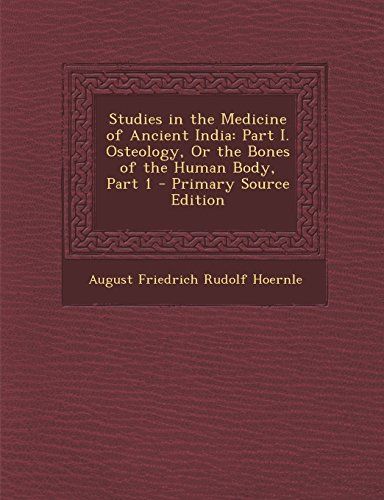Sushruta & his Samhita - Part 6 - Hoernlé, the Persistent.

In the previous part, we learnt that Bower took the pothi to Simla and upon his return forwarded it to Colonel James Waterhouse, the then President of the Asiatic Society of Bengal. Since Hamilton Bower discovered it, the pothi came to be known as the Bower Manuscript.
Waterhouse exhibited the manuscript at the monthly meeting of the Society on 5 November 5, 1890. Initial attempts to decipher the manuscript proved unsuccessful until German Indologist Georg Buhler succeeded in reading and translating two leaves of the manuscript.
Here enters the most important characters of our story. Augustus Frederic Rudolf Hoernlé, a German-British Orientalist.
Hoernlé was born in Secundra, Agra, British India in a Protestant missionary family he descended from a long line of missionaries which included both linguists and revolutionaries. Hoernlé was a British subject by birth; he was sent to Germany to his grandparents, at age 7, and was initially educated there.
Hoernlé attended school in Switzerland, after completing theological studies in Schönthal and the University of Basle later moving to London and studying Sanskrit under Theodor Goldstucker. He returned to India in 1865, teaching first at the Benares Hindu University and later at the University of Calcutta.¹
As the pothi was discovered in the Asian plains, Hoernlé was given the Bower Manuscript to decipher in February 1891. He faced some complex challenges.

Leaf from the Bower Manuscript — Image provided by Sanket Kulkarni
First is the language itself — Despite his study in Sanskrit and knowledge of other regional languages, he was left dumbfounded. The language appeared Sanskrit, but wasn’t nor was it written in a known script — It was unlike anything known at the time.
Here’s a small example to illustrate his difficulty. You can read the word ‘example’, but not when it is written in Devnagari script एक्षाम्पल्. What if I wrote बाएस्पिएल्? That’s ‘beispiel’ or example in German. So now you need someone who can read and write, English-German-Devnagari script! This was an impossible task.
The second challenge was that the manuscript was written on birch leaves and had weathered for centuries. Some of the text had become illegible.
Here we must appreciate Hoernlé’s tenacity. He studied several reference scriptures and eventually worked out that the script was “Gupt Bramhi lipi”.
The Gupta Empire, founded by Maharaja Sri Gupta, was an Indian realm that covered much of the Indian Subcontinent from approximately 320–550 CE. Gupta rule, while solidified by territorial expansion through war, began a period of peace and prosperity marked by advancements in science, technology, engineering, art, dialectics, literature, logic, mathematics, astronomy, religion, and philosophy.²
Although Hoernlé now knew the script, Hoernlé still didn’t know the language it was written in. During his research he learnt that several Buddhist texts of the time were written in Bramhi lipi, so he started studying Buddhism.
His persistence paid off and Hoernlé discovered that the Bower manuscript contained a hybrid language written in Gupt Brahmi script!
Hoernlé worked diligently for almost 4 years before he could publish a complete index of the text, featuring an annotated English translation and illustrated facsimile plates between 1893 and 1897.

The Bower Manuscript Index
A Sanskrit Index was published in 1908, and a revised translation of the medical portions (I, II, and III) in 1909; the Introduction appeared in 1912. The publication was completed in 1914. Hoernlé spent nearly two decades on deciphering the Bower Manuscript.
He estimated the scripture to be from 600 BC, making it the oldest Indian document ever to be found.
Several British newspapers reported these findings unleashing a stampede of sorts as archaeologists, explorers, researchers as well as plunderers and forgers made their way to the East and Central Asia. Many of them did go on to find items of interest, but nothing as significant as the Bower Manuscript.
With that our manuscript has been successfully deciphered, in the next chapter, we will look at the treasures it held within.
Join this fascinating journey to find out more.
Twitter:https://twitter.com/mitra_tejomaya
Youtube: http://bit.ly/TejomayaBharat?sub_confirmation=1
Resources:
1: En.wikipedia.org. (2019). Rudolf Hoernlé. [online] Available at: https://en.wikipedia.org/wiki/Rudolf_Hoernl%C3%A9 [Accessed 3 Aug. 2019].
2: Courses.lumenlearning.com. (2019). The Gupta Empire | Boundless World History. [online] Available at: https://courses.lumenlearning.com/boundless-worldhistory/chapter/the-gupta-empire/ [Accessed 3 Aug. 2019]

Comments ()